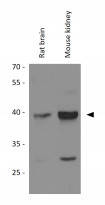ARG55294
anti-ASNA1 antibody
anti-ASNA1 antibody for ICC/IF,Western blot and Human,Mouse,Rat
Cell Biology and Cellular Response antibody; Metabolism antibody; Signaling Transduction antibody
Overview
| Product Description | Rabbit Polyclonal antibody recognizes ASNA1 |
|---|---|
| Tested Reactivity | Hu, Ms, Rat |
| Tested Application | ICC/IF, WB |
| Host | Rabbit |
| Clonality | Polyclonal |
| Isotype | IgG |
| Target Name | ASNA1 |
| Antigen Species | Human |
| Immunogen | Recombinant protein of Human ASNA1 (NP_004308.2) |
| Conjugation | Un-conjugated |
| Alternate Names | EC 3.6.-.-; GET3; ARSA-I; Arsenite-stimulated ATPase; ATPase ASNA1; hARSA-I; hASNA-I; Transmembrane domain recognition complex 40 kDa ATPase subunit; ARSA1; TRC40; ASNA-I; Arsenical pump-driving ATPase |
Application Instructions
| Application Suggestion |
|
||||||
|---|---|---|---|---|---|---|---|
| Application Note | * The dilutions indicate recommended starting dilutions and the optimal dilutions or concentrations should be determined by the scientist. | ||||||
| Positive Control | Rat brain, Mouse kidney and MCF7 | ||||||
| Observed Size | ~ 40 kDa |
Properties
| Form | Liquid |
|---|---|
| Purification | Affinity purification with immunogen. |
| Buffer | PBS (pH 7.3), 0.02% Sodium azide and 50% Glycerol |
| Preservative | 0.02% Sodium azide |
| Stabilizer | 50% Glycerol |
| Storage Instruction | For continuous use, store undiluted antibody at 2-8°C for up to a week. For long-term storage, aliquot and store at -20°C. Storage in frost free freezers is not recommended. Avoid repeated freeze/thaw cycles. Suggest spin the vial prior to opening. The antibody solution should be gently mixed before use. |
| Note | For laboratory research only, not for drug, diagnostic or other use. |
Bioinformation
| Database Links | |
|---|---|
| Gene Symbol | ASNA1 |
| Gene Full Name | arsA arsenite transporter, ATP-binding, homolog 1 (bacterial) |
| Background | This gene represents the human homolog of the bacterial arsA gene, encoding the arsenite-stimulated ATPase component of the arsenite transporter responsible for resistance to arsenicals. This protein is also a central component of a transmembrane domain (TMD) recognition complex (TRC) that is involved in the post-translational delivery of tail-anchored (TA) proteins from the cytosol to the endoplasmic reticulum (ER). It recognizes and selectively binds the TMD of TA proteins in the cytosol, and delivers them to the ER for insertion. [provided by RefSeq, Oct 2011] |
| Function | ATPase required for the post-translational delivery of tail-anchored (TA) proteins to the endoplasmic reticulum. Recognizes and selectively binds the transmembrane domain of TA proteins in the cytosol. This complex then targets to the endoplasmic reticulum by membrane-bound receptors, where the tail-anchored protein is released for insertion. This process is regulated by ATP binding and hydrolysis. ATP binding drives the homodimer towards the closed dimer state, facilitating recognition of newly synthesized TA membrane proteins. ATP hydrolysis is required for insertion. Subsequently, the homodimer reverts towards the open dimer state, lowering its affinity for the membrane-bound receptor, and returning it to the cytosol to initiate a new round of targeting (By similarity). May be involved in insulin signaling. [UniProt] |
| Research Area | Cell Biology and Cellular Response antibody; Metabolism antibody; Signaling Transduction antibody |
| Calculated MW | 39 kDa |
Images (2) Click the Picture to Zoom In







